BTEC HND in Civil Engineering: Analytical Methods Assignment
VerifiedAdded on 2021/07/28
|42
|4482
|161
Homework Assignment
AI Summary
This document presents a comprehensive assignment solution for BTEC HND in Civil Engineering, focusing on analytical methods for engineers. The assignment covers a range of topics including solving simultaneous equations using the matrix method, sketching functions, and performing factorisation. It also delves into algebraic manipulations like partial fractions and algebraic division. The second task addresses practical applications, such as calculating forces in ropes, determining volumes, and finding room dimensions. Trigonometry, including sinusoidal waves and logarithmic relationships, is also explored. The third task involves calculus, focusing on finding gradients, optimisation problems related to poster design, and static force analysis. Finally, the assignment incorporates statistical concepts such as calculating mean and standard deviation, probability calculations involving different scenarios, and the application of probability to exam scenarios. The document includes an executive summary, table of contents, and references, providing a complete and detailed solution.
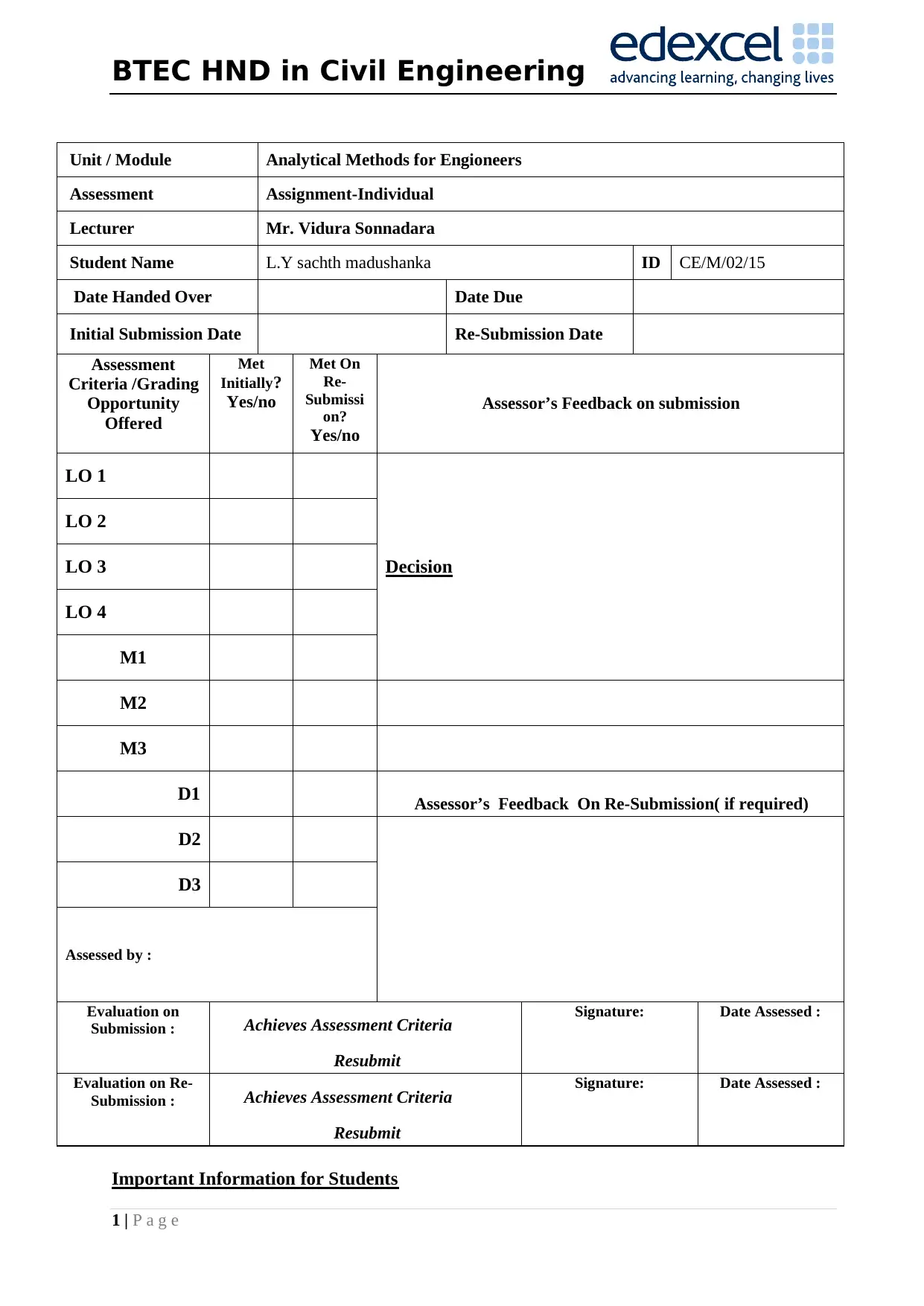
BTEC HND in Civil Engineering
1 | P a g e
Unit / Module Analytical Methods for Engioneers
Assessment Assignment-Individual
Lecturer Mr. Vidura Sonnadara
Student Name L.Y sachth madushanka ID CE/M/02/15
Date Handed Over Date Due
Initial Submission Date Re-Submission Date
Assessment
Criteria /Grading
Opportunity
Offered
Met
Initially?
Yes/no
Met On
Re-
Submissi
on?
Yes/no
Assessor’s Feedback on submission
LO 1
Decision
LO 2
LO 3
LO 4
M1
M2
M3
D1 Assessor’s Feedback On Re-Submission( if required)
D2
D3
Assessed by :
Evaluation on
Submission : Achieves Assessment Criteria
Resubmit
Signature: Date Assessed :
Evaluation on Re-
Submission : Achieves Assessment Criteria
Resubmit
Signature: Date Assessed :
Important Information for Students
1 | P a g e
Unit / Module Analytical Methods for Engioneers
Assessment Assignment-Individual
Lecturer Mr. Vidura Sonnadara
Student Name L.Y sachth madushanka ID CE/M/02/15
Date Handed Over Date Due
Initial Submission Date Re-Submission Date
Assessment
Criteria /Grading
Opportunity
Offered
Met
Initially?
Yes/no
Met On
Re-
Submissi
on?
Yes/no
Assessor’s Feedback on submission
LO 1
Decision
LO 2
LO 3
LO 4
M1
M2
M3
D1 Assessor’s Feedback On Re-Submission( if required)
D2
D3
Assessed by :
Evaluation on
Submission : Achieves Assessment Criteria
Resubmit
Signature: Date Assessed :
Evaluation on Re-
Submission : Achieves Assessment Criteria
Resubmit
Signature: Date Assessed :
Important Information for Students
Paraphrase This Document
Need a fresh take? Get an instant paraphrase of this document with our AI Paraphraser
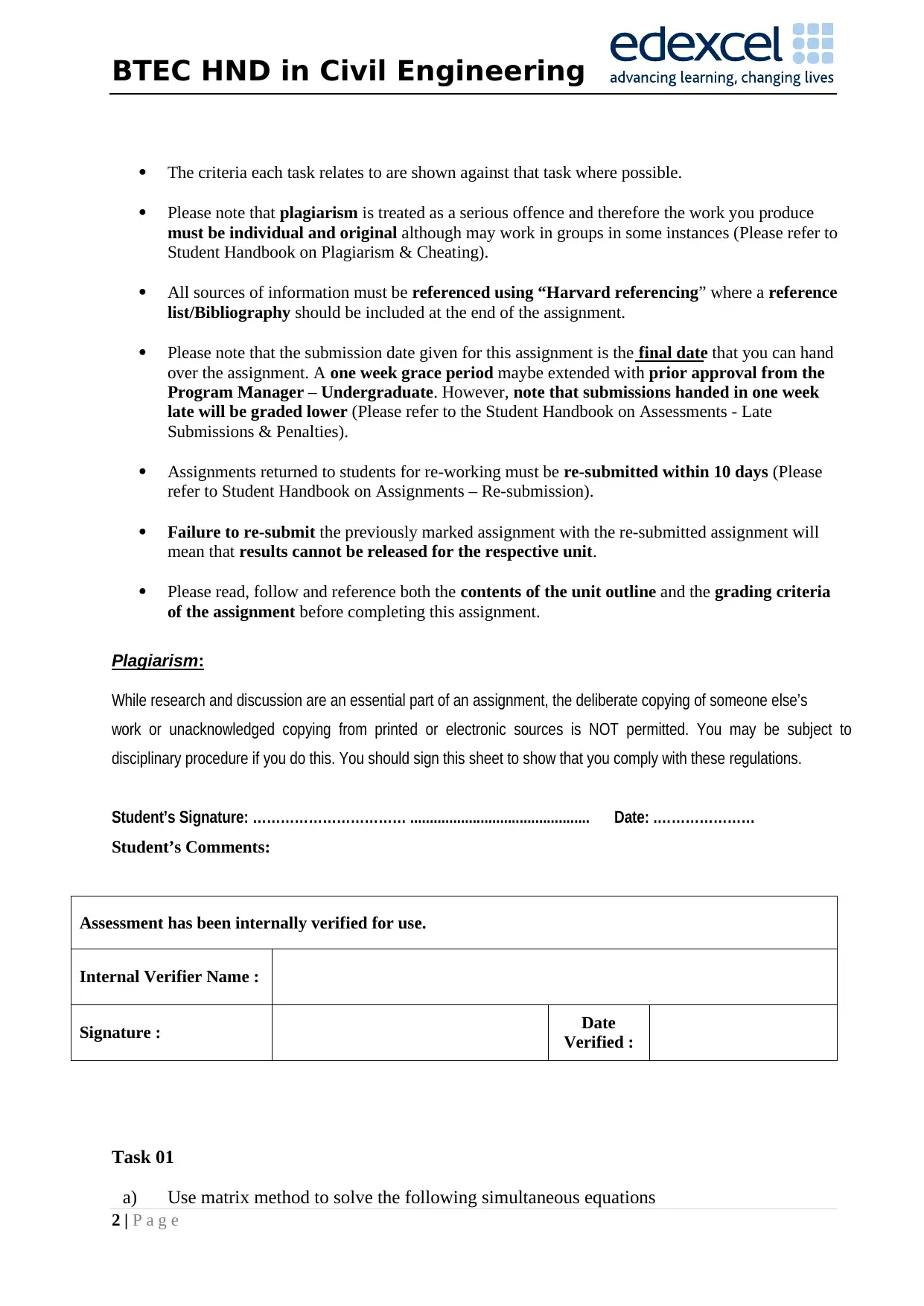
BTEC HND in Civil Engineering
2 | P a g e
The criteria each task relates to are shown against that task where possible.
Please note that plagiarism is treated as a serious offence and therefore the work you produce
must be individual and original although may work in groups in some instances (Please refer to
Student Handbook on Plagiarism & Cheating).
All sources of information must be referenced using “Harvard referencing” where a reference
list/Bibliography should be included at the end of the assignment.
Please note that the submission date given for this assignment is the final date that you can hand
over the assignment. A one week grace period maybe extended with prior approval from the
Program Manager – Undergraduate. However, note that submissions handed in one week
late will be graded lower (Please refer to the Student Handbook on Assessments - Late
Submissions & Penalties).
Assignments returned to students for re-working must be re-submitted within 10 days (Please
refer to Student Handbook on Assignments – Re-submission).
Failure to re-submit the previously marked assignment with the re-submitted assignment will
mean that results cannot be released for the respective unit.
Please read, follow and reference both the contents of the unit outline and the grading criteria
of the assignment before completing this assignment.
Plagiarism:
While research and discussion are an essential part of an assignment, the deliberate copying of someone else’s
work or unacknowledged copying from printed or electronic sources is NOT permitted. You may be subject to
disciplinary procedure if you do this. You should sign this sheet to show that you comply with these regulations.
Student’s Signature: …………………………… .............................................. Date: .…………………
Student’s Comments:
Assessment has been internally verified for use.
Internal Verifier Name :
Signature : Date
Verified :
Task 01
a) Use matrix method to solve the following simultaneous equations
2 | P a g e
The criteria each task relates to are shown against that task where possible.
Please note that plagiarism is treated as a serious offence and therefore the work you produce
must be individual and original although may work in groups in some instances (Please refer to
Student Handbook on Plagiarism & Cheating).
All sources of information must be referenced using “Harvard referencing” where a reference
list/Bibliography should be included at the end of the assignment.
Please note that the submission date given for this assignment is the final date that you can hand
over the assignment. A one week grace period maybe extended with prior approval from the
Program Manager – Undergraduate. However, note that submissions handed in one week
late will be graded lower (Please refer to the Student Handbook on Assessments - Late
Submissions & Penalties).
Assignments returned to students for re-working must be re-submitted within 10 days (Please
refer to Student Handbook on Assignments – Re-submission).
Failure to re-submit the previously marked assignment with the re-submitted assignment will
mean that results cannot be released for the respective unit.
Please read, follow and reference both the contents of the unit outline and the grading criteria
of the assignment before completing this assignment.
Plagiarism:
While research and discussion are an essential part of an assignment, the deliberate copying of someone else’s
work or unacknowledged copying from printed or electronic sources is NOT permitted. You may be subject to
disciplinary procedure if you do this. You should sign this sheet to show that you comply with these regulations.
Student’s Signature: …………………………… .............................................. Date: .…………………
Student’s Comments:
Assessment has been internally verified for use.
Internal Verifier Name :
Signature : Date
Verified :
Task 01
a) Use matrix method to solve the following simultaneous equations
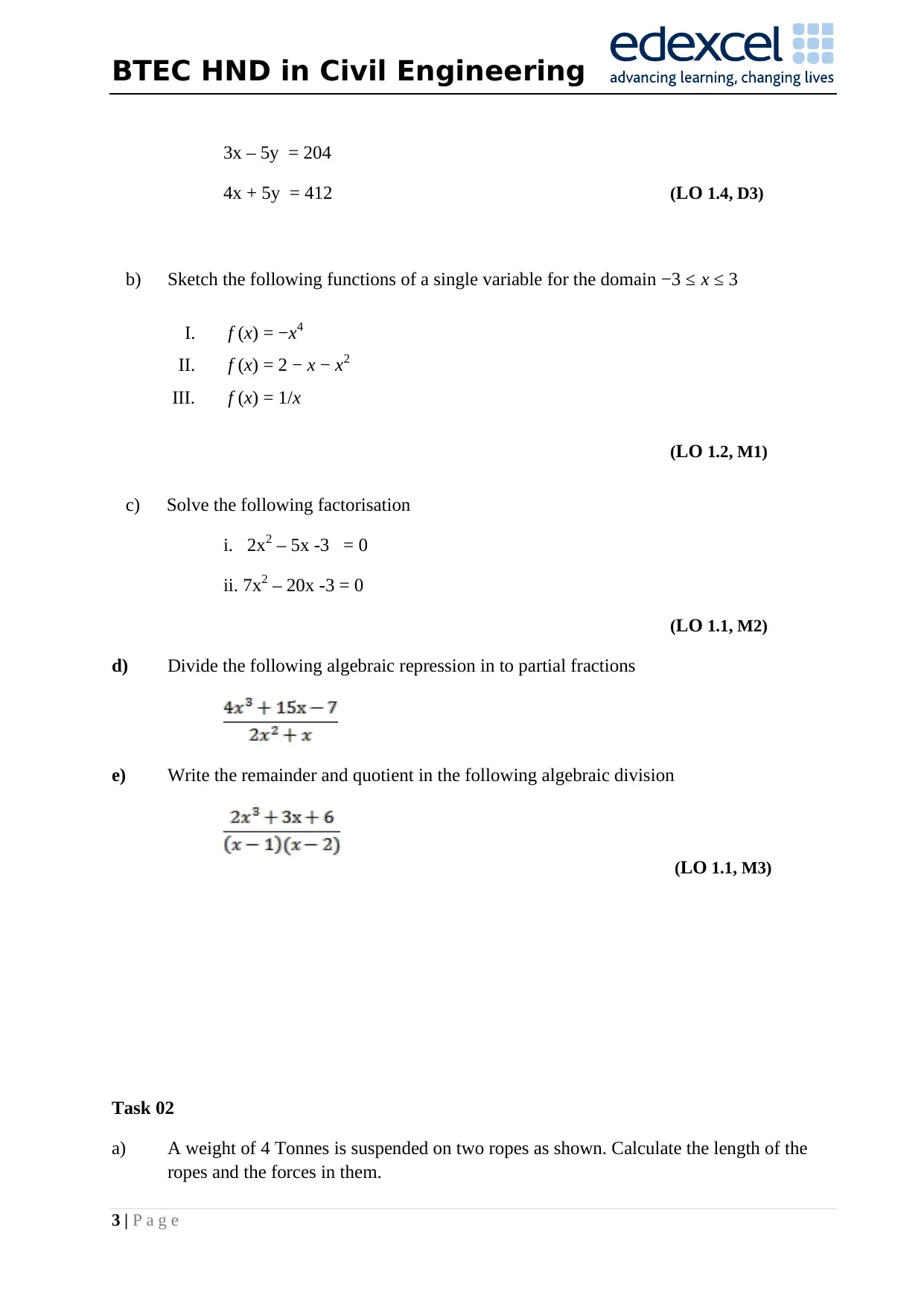
BTEC HND in Civil Engineering
3 | P a g e
3x – 5y = 204
4x + 5y = 412 (LO 1.4, D3)
b) Sketch the following functions of a single variable for the domain −3 ≤ x ≤ 3
I. f (x) = −x4
II. f (x) = 2 − x − x2
III. f (x) = 1/x
(LO 1.2, M1)
c) Solve the following factorisation
i. 2x2 – 5x -3 = 0
ii. 7x2 – 20x -3 = 0
(LO 1.1, M2)
d) Divide the following algebraic repression in to partial fractions
e) Write the remainder and quotient in the following algebraic division
(LO 1.1, M3)
Task 02
a) A weight of 4 Tonnes is suspended on two ropes as shown. Calculate the length of the
ropes and the forces in them.
3 | P a g e
3x – 5y = 204
4x + 5y = 412 (LO 1.4, D3)
b) Sketch the following functions of a single variable for the domain −3 ≤ x ≤ 3
I. f (x) = −x4
II. f (x) = 2 − x − x2
III. f (x) = 1/x
(LO 1.2, M1)
c) Solve the following factorisation
i. 2x2 – 5x -3 = 0
ii. 7x2 – 20x -3 = 0
(LO 1.1, M2)
d) Divide the following algebraic repression in to partial fractions
e) Write the remainder and quotient in the following algebraic division
(LO 1.1, M3)
Task 02
a) A weight of 4 Tonnes is suspended on two ropes as shown. Calculate the length of the
ropes and the forces in them.
⊘ This is a preview!⊘
Do you want full access?
Subscribe today to unlock all pages.

Trusted by 1+ million students worldwide
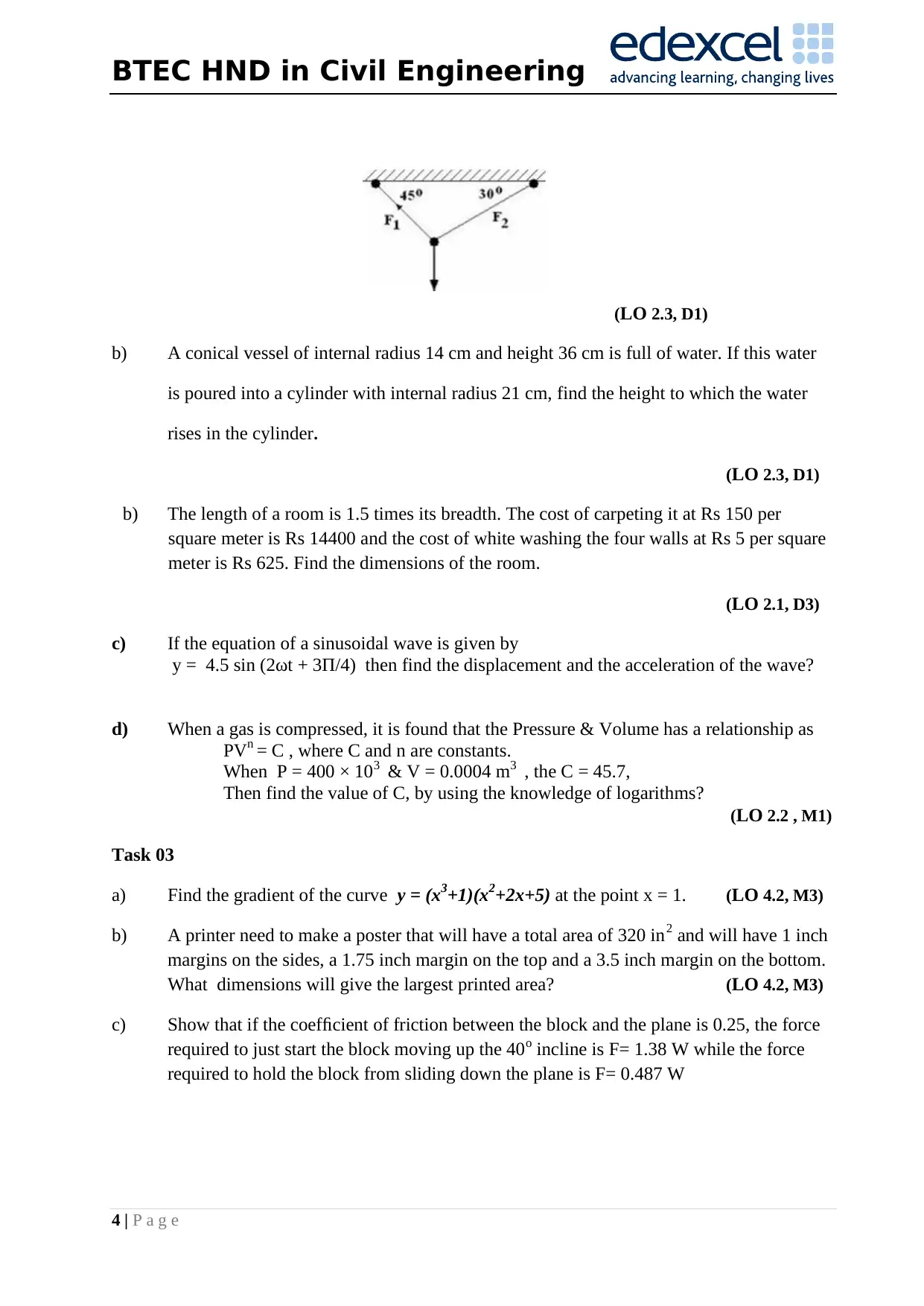
BTEC HND in Civil Engineering
4 | P a g e
(LO 2.3, D1)
b) A conical vessel of internal radius 14 cm and height 36 cm is full of water. If this water
is poured into a cylinder with internal radius 21 cm, find the height to which the water
rises in the cylinder.
(LO 2.3, D1)
b) The length of a room is 1.5 times its breadth. The cost of carpeting it at Rs 150 per
square meter is Rs 14400 and the cost of white washing the four walls at Rs 5 per square
meter is Rs 625. Find the dimensions of the room.
(LO 2.1, D3)
c) If the equation of a sinusoidal wave is given by
y = 4.5 sin (2ωt + 3Π/4) then find the displacement and the acceleration of the wave?
d) When a gas is compressed, it is found that the Pressure & Volume has a relationship as
PVn = C , where C and n are constants.
When P = 400 × 103 & V = 0.0004 m3 , the C = 45.7,
Then find the value of C, by using the knowledge of logarithms?
(LO 2.2 , M1)
Task 03
a) Find the gradient of the curve y = (x3+1)(x2+2x+5) at the point x = 1. (LO 4.2, M3)
b) A printer need to make a poster that will have a total area of 320 in2 and will have 1 inch
margins on the sides, a 1.75 inch margin on the top and a 3.5 inch margin on the bottom.
What dimensions will give the largest printed area? (LO 4.2, M3)
c) Show that if the coefficient of friction between the block and the plane is 0.25, the force
required to just start the block moving up the 40o incline is F= 1.38 W while the force
required to hold the block from sliding down the plane is F= 0.487 W
4 | P a g e
(LO 2.3, D1)
b) A conical vessel of internal radius 14 cm and height 36 cm is full of water. If this water
is poured into a cylinder with internal radius 21 cm, find the height to which the water
rises in the cylinder.
(LO 2.3, D1)
b) The length of a room is 1.5 times its breadth. The cost of carpeting it at Rs 150 per
square meter is Rs 14400 and the cost of white washing the four walls at Rs 5 per square
meter is Rs 625. Find the dimensions of the room.
(LO 2.1, D3)
c) If the equation of a sinusoidal wave is given by
y = 4.5 sin (2ωt + 3Π/4) then find the displacement and the acceleration of the wave?
d) When a gas is compressed, it is found that the Pressure & Volume has a relationship as
PVn = C , where C and n are constants.
When P = 400 × 103 & V = 0.0004 m3 , the C = 45.7,
Then find the value of C, by using the knowledge of logarithms?
(LO 2.2 , M1)
Task 03
a) Find the gradient of the curve y = (x3+1)(x2+2x+5) at the point x = 1. (LO 4.2, M3)
b) A printer need to make a poster that will have a total area of 320 in2 and will have 1 inch
margins on the sides, a 1.75 inch margin on the top and a 3.5 inch margin on the bottom.
What dimensions will give the largest printed area? (LO 4.2, M3)
c) Show that if the coefficient of friction between the block and the plane is 0.25, the force
required to just start the block moving up the 40o incline is F= 1.38 W while the force
required to hold the block from sliding down the plane is F= 0.487 W
Paraphrase This Document
Need a fresh take? Get an instant paraphrase of this document with our AI Paraphraser
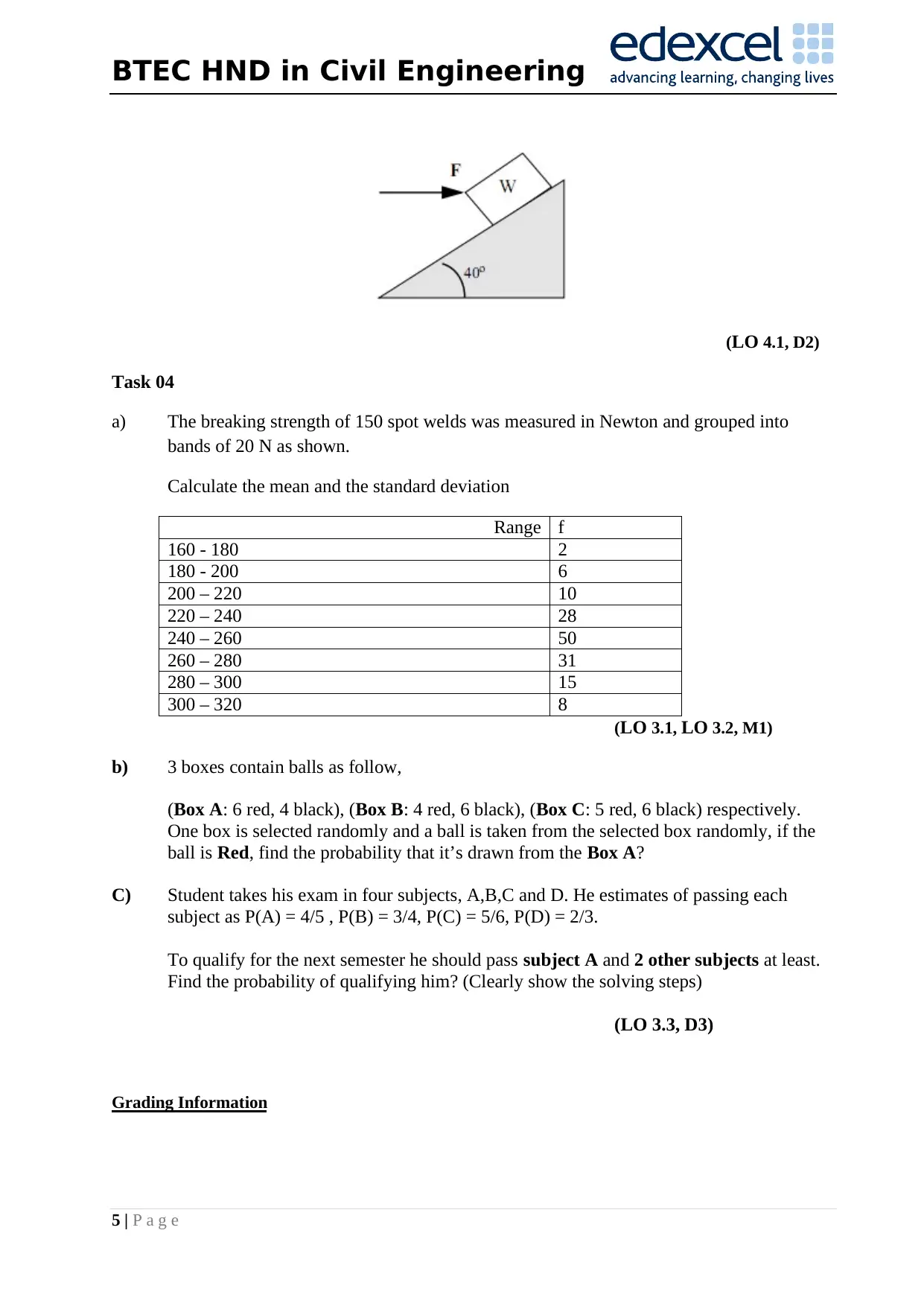
BTEC HND in Civil Engineering
5 | P a g e
(LO 4.1, D2)
Task 04
a) The breaking strength of 150 spot welds was measured in Newton and grouped into
bands of 20 N as shown.
Calculate the mean and the standard deviation
Range f
160 - 180 2
180 - 200 6
200 – 220 10
220 – 240 28
240 – 260 50
260 – 280 31
280 – 300 15
300 – 320 8
(LO 3.1, LO 3.2, M1)
b) 3 boxes contain balls as follow,
(Box A: 6 red, 4 black), (Box B: 4 red, 6 black), (Box C: 5 red, 6 black) respectively.
One box is selected randomly and a ball is taken from the selected box randomly, if the
ball is Red, find the probability that it’s drawn from the Box A?
C) Student takes his exam in four subjects, A,B,C and D. He estimates of passing each
subject as P(A) = 4/5 , P(B) = 3/4, P(C) = 5/6, P(D) = 2/3.
To qualify for the next semester he should pass subject A and 2 other subjects at least.
Find the probability of qualifying him? (Clearly show the solving steps)
(LO 3.3, D3)
Grading Information
5 | P a g e
(LO 4.1, D2)
Task 04
a) The breaking strength of 150 spot welds was measured in Newton and grouped into
bands of 20 N as shown.
Calculate the mean and the standard deviation
Range f
160 - 180 2
180 - 200 6
200 – 220 10
220 – 240 28
240 – 260 50
260 – 280 31
280 – 300 15
300 – 320 8
(LO 3.1, LO 3.2, M1)
b) 3 boxes contain balls as follow,
(Box A: 6 red, 4 black), (Box B: 4 red, 6 black), (Box C: 5 red, 6 black) respectively.
One box is selected randomly and a ball is taken from the selected box randomly, if the
ball is Red, find the probability that it’s drawn from the Box A?
C) Student takes his exam in four subjects, A,B,C and D. He estimates of passing each
subject as P(A) = 4/5 , P(B) = 3/4, P(C) = 5/6, P(D) = 2/3.
To qualify for the next semester he should pass subject A and 2 other subjects at least.
Find the probability of qualifying him? (Clearly show the solving steps)
(LO 3.3, D3)
Grading Information
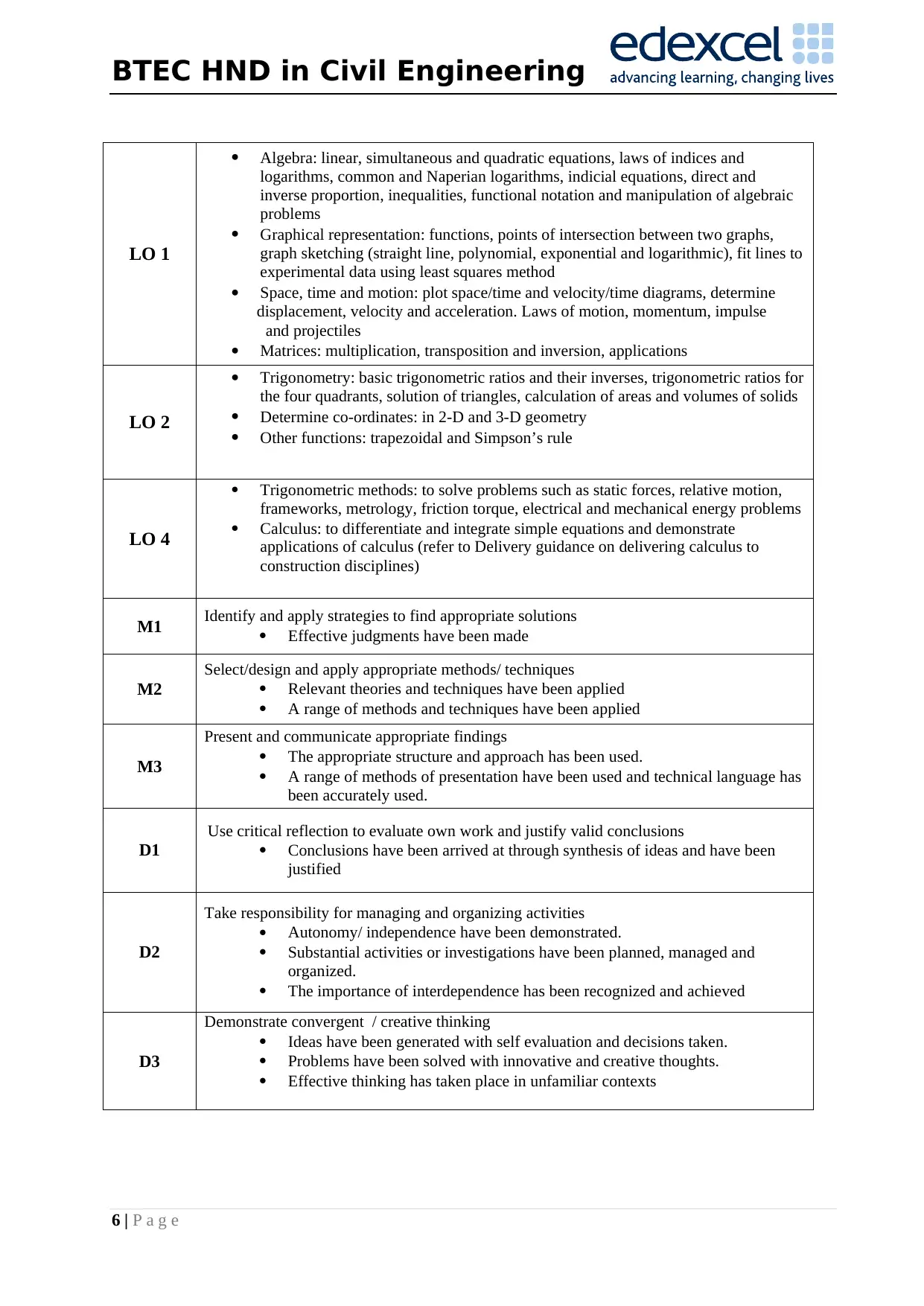
BTEC HND in Civil Engineering
6 | P a g e
LO 1
Algebra: linear, simultaneous and quadratic equations, laws of indices and
logarithms, common and Naperian logarithms, indicial equations, direct and
inverse proportion, inequalities, functional notation and manipulation of algebraic
problems
Graphical representation: functions, points of intersection between two graphs,
graph sketching (straight line, polynomial, exponential and logarithmic), fit lines to
experimental data using least squares method
Space, time and motion: plot space/time and velocity/time diagrams, determine
displacement, velocity and acceleration. Laws of motion, momentum, impulse
and projectiles
Matrices: multiplication, transposition and inversion, applications
LO 2
Trigonometry: basic trigonometric ratios and their inverses, trigonometric ratios for
the four quadrants, solution of triangles, calculation of areas and volumes of solids
Determine co-ordinates: in 2-D and 3-D geometry
Other functions: trapezoidal and Simpson’s rule
LO 4
Trigonometric methods: to solve problems such as static forces, relative motion,
frameworks, metrology, friction torque, electrical and mechanical energy problems
Calculus: to differentiate and integrate simple equations and demonstrate
applications of calculus (refer to Delivery guidance on delivering calculus to
construction disciplines)
M1 Identify and apply strategies to find appropriate solutions
Effective judgments have been made
M2
Select/design and apply appropriate methods/ techniques
Relevant theories and techniques have been applied
A range of methods and techniques have been applied
M3
Present and communicate appropriate findings
The appropriate structure and approach has been used.
A range of methods of presentation have been used and technical language has
been accurately used.
D1
Use critical reflection to evaluate own work and justify valid conclusions
Conclusions have been arrived at through synthesis of ideas and have been
justified
D2
Take responsibility for managing and organizing activities
Autonomy/ independence have been demonstrated.
Substantial activities or investigations have been planned, managed and
organized.
The importance of interdependence has been recognized and achieved
D3
Demonstrate convergent / creative thinking
Ideas have been generated with self evaluation and decisions taken.
Problems have been solved with innovative and creative thoughts.
Effective thinking has taken place in unfamiliar contexts
6 | P a g e
LO 1
Algebra: linear, simultaneous and quadratic equations, laws of indices and
logarithms, common and Naperian logarithms, indicial equations, direct and
inverse proportion, inequalities, functional notation and manipulation of algebraic
problems
Graphical representation: functions, points of intersection between two graphs,
graph sketching (straight line, polynomial, exponential and logarithmic), fit lines to
experimental data using least squares method
Space, time and motion: plot space/time and velocity/time diagrams, determine
displacement, velocity and acceleration. Laws of motion, momentum, impulse
and projectiles
Matrices: multiplication, transposition and inversion, applications
LO 2
Trigonometry: basic trigonometric ratios and their inverses, trigonometric ratios for
the four quadrants, solution of triangles, calculation of areas and volumes of solids
Determine co-ordinates: in 2-D and 3-D geometry
Other functions: trapezoidal and Simpson’s rule
LO 4
Trigonometric methods: to solve problems such as static forces, relative motion,
frameworks, metrology, friction torque, electrical and mechanical energy problems
Calculus: to differentiate and integrate simple equations and demonstrate
applications of calculus (refer to Delivery guidance on delivering calculus to
construction disciplines)
M1 Identify and apply strategies to find appropriate solutions
Effective judgments have been made
M2
Select/design and apply appropriate methods/ techniques
Relevant theories and techniques have been applied
A range of methods and techniques have been applied
M3
Present and communicate appropriate findings
The appropriate structure and approach has been used.
A range of methods of presentation have been used and technical language has
been accurately used.
D1
Use critical reflection to evaluate own work and justify valid conclusions
Conclusions have been arrived at through synthesis of ideas and have been
justified
D2
Take responsibility for managing and organizing activities
Autonomy/ independence have been demonstrated.
Substantial activities or investigations have been planned, managed and
organized.
The importance of interdependence has been recognized and achieved
D3
Demonstrate convergent / creative thinking
Ideas have been generated with self evaluation and decisions taken.
Problems have been solved with innovative and creative thoughts.
Effective thinking has taken place in unfamiliar contexts
⊘ This is a preview!⊘
Do you want full access?
Subscribe today to unlock all pages.

Trusted by 1+ million students worldwide
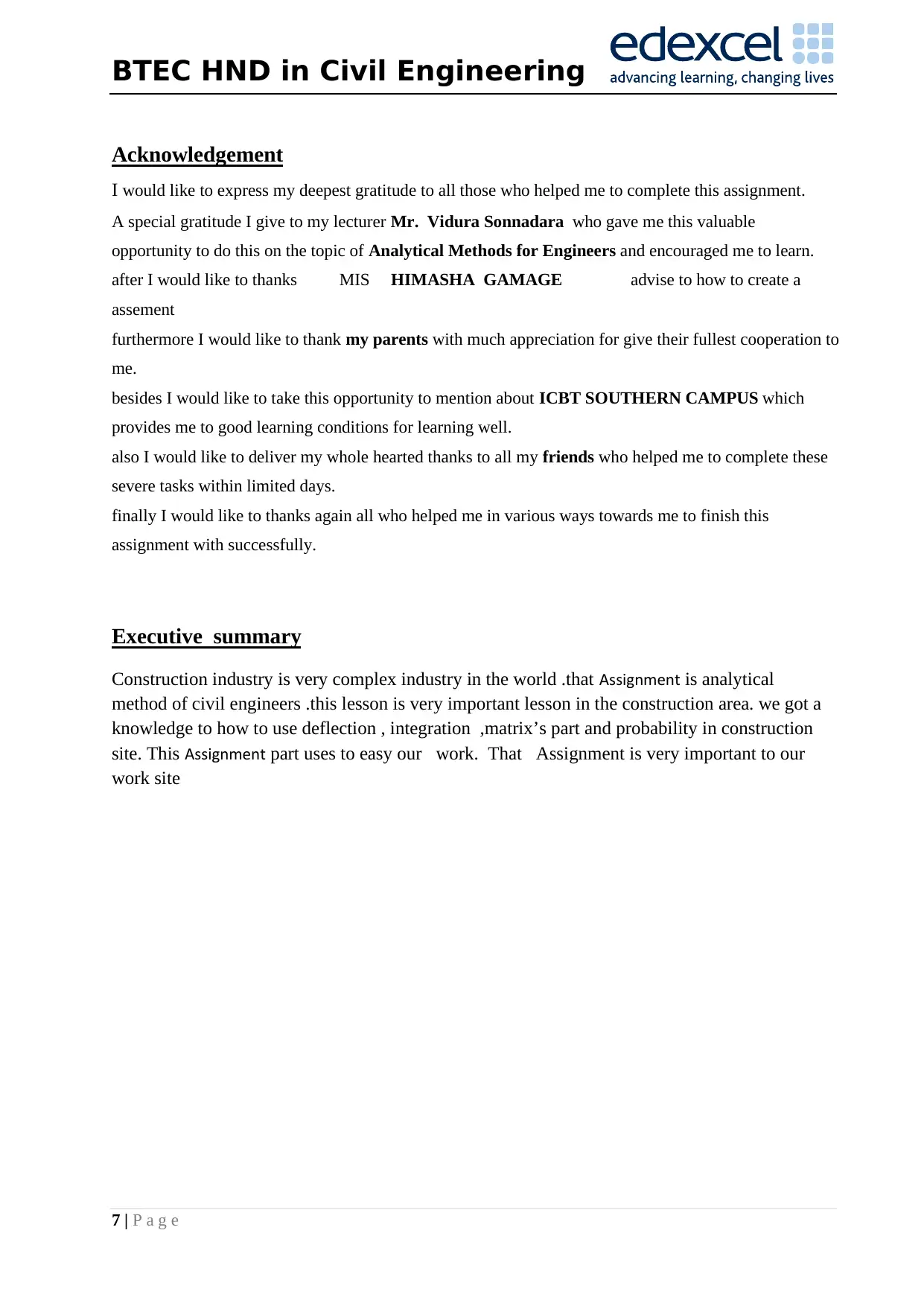
BTEC HND in Civil Engineering
7 | P a g e
Acknowledgement
I would like to express my deepest gratitude to all those who helped me to complete this assignment.
A special gratitude I give to my lecturer Mr. Vidura Sonnadara who gave me this valuable
opportunity to do this on the topic of Analytical Methods for Engineers and encouraged me to learn.
after I would like to thanks MIS HIMASHA GAMAGE advise to how to create a
assement
furthermore I would like to thank my parents with much appreciation for give their fullest cooperation to
me.
besides I would like to take this opportunity to mention about ICBT SOUTHERN CAMPUS which
provides me to good learning conditions for learning well.
also I would like to deliver my whole hearted thanks to all my friends who helped me to complete these
severe tasks within limited days.
finally I would like to thanks again all who helped me in various ways towards me to finish this
assignment with successfully.
Executive summary
Construction industry is very complex industry in the world .that Assignment is analytical
method of civil engineers .this lesson is very important lesson in the construction area. we got a
knowledge to how to use deflection , integration ,matrix’s part and probability in construction
site. This Assignment part uses to easy our work. That Assignment is very important to our
work site
7 | P a g e
Acknowledgement
I would like to express my deepest gratitude to all those who helped me to complete this assignment.
A special gratitude I give to my lecturer Mr. Vidura Sonnadara who gave me this valuable
opportunity to do this on the topic of Analytical Methods for Engineers and encouraged me to learn.
after I would like to thanks MIS HIMASHA GAMAGE advise to how to create a
assement
furthermore I would like to thank my parents with much appreciation for give their fullest cooperation to
me.
besides I would like to take this opportunity to mention about ICBT SOUTHERN CAMPUS which
provides me to good learning conditions for learning well.
also I would like to deliver my whole hearted thanks to all my friends who helped me to complete these
severe tasks within limited days.
finally I would like to thanks again all who helped me in various ways towards me to finish this
assignment with successfully.
Executive summary
Construction industry is very complex industry in the world .that Assignment is analytical
method of civil engineers .this lesson is very important lesson in the construction area. we got a
knowledge to how to use deflection , integration ,matrix’s part and probability in construction
site. This Assignment part uses to easy our work. That Assignment is very important to our
work site
Paraphrase This Document
Need a fresh take? Get an instant paraphrase of this document with our AI Paraphraser
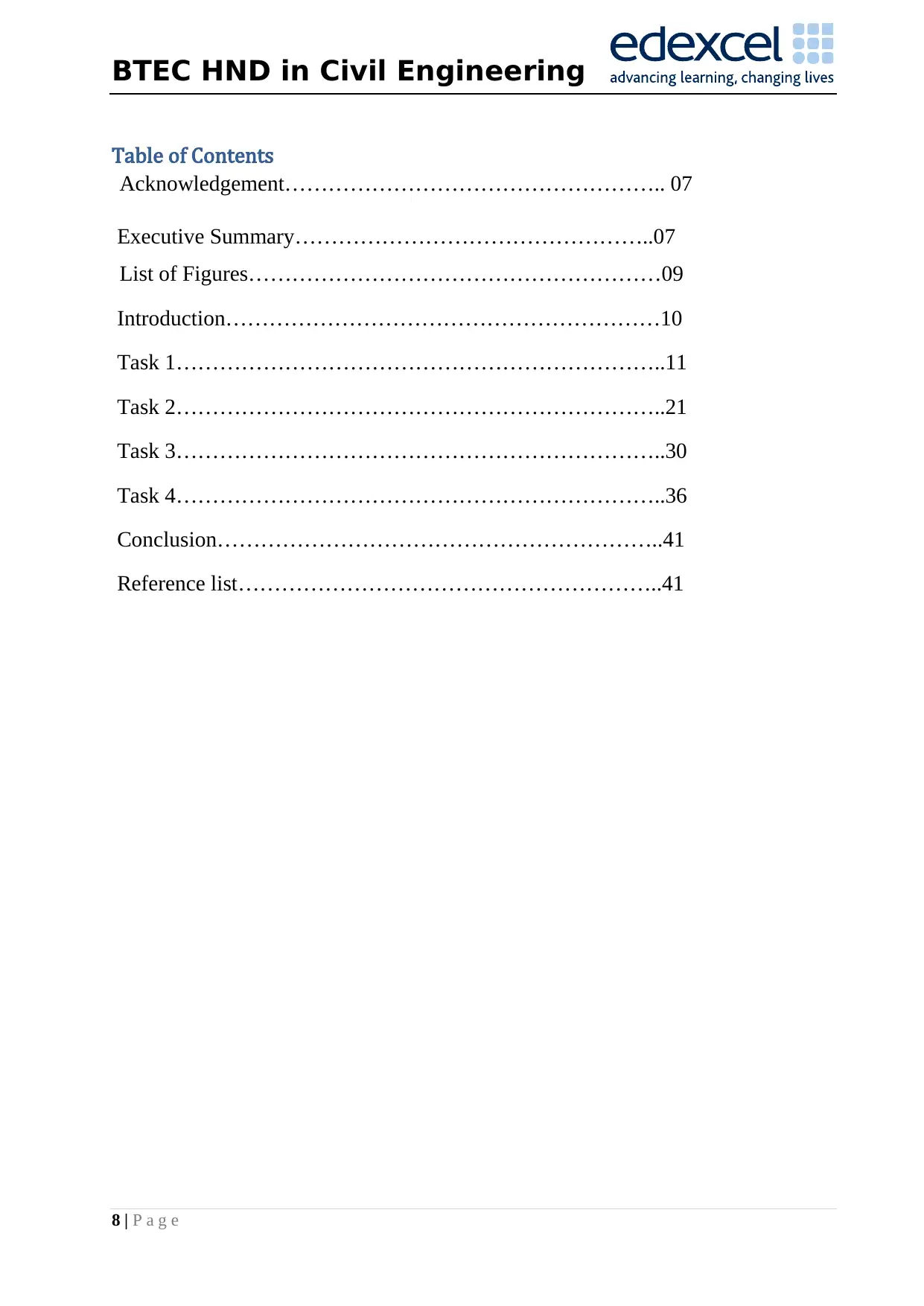
BTEC HND in Civil Engineering
8 | P a g e
Table of Contents
Acknowledgement…………………………………………….. 07
Executive Summary…………………………………………..07
List of Figures…………………………………………………09
Introduction……………………………………………………10
Task 1…………………………………………………………..11
Task 2…………………………………………………………..21
Task 3…………………………………………………………..30
Task 4…………………………………………………………..36
Conclusion……………………………………………………..41
Reference list…………………………………………………..41
8 | P a g e
Table of Contents
Acknowledgement…………………………………………….. 07
Executive Summary…………………………………………..07
List of Figures…………………………………………………09
Introduction……………………………………………………10
Task 1…………………………………………………………..11
Task 2…………………………………………………………..21
Task 3…………………………………………………………..30
Task 4…………………………………………………………..36
Conclusion……………………………………………………..41
Reference list…………………………………………………..41
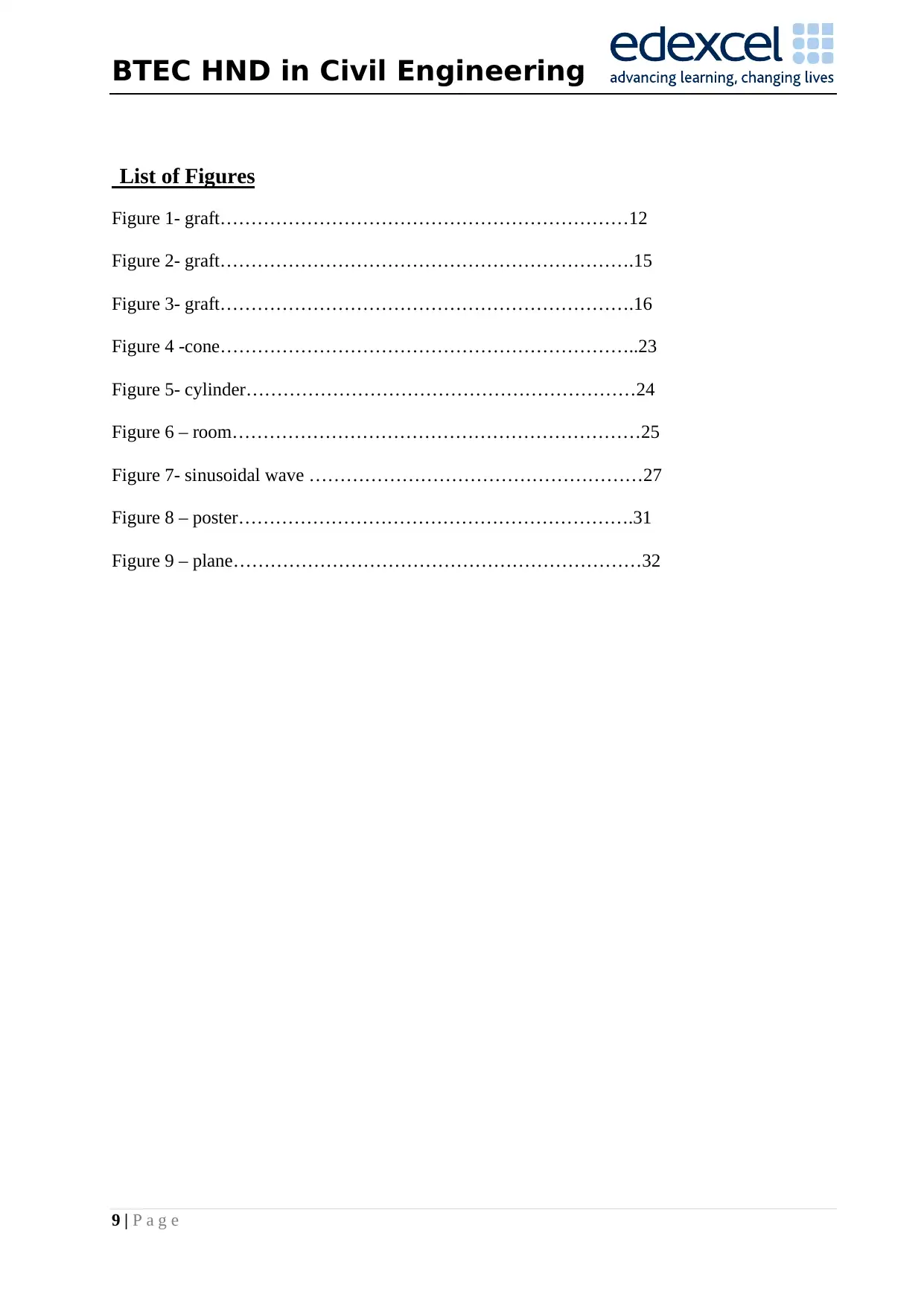
BTEC HND in Civil Engineering
9 | P a g e
List of Figures
Figure 1- graft…………………………………………………………12
Figure 2- graft………………………………………………………….15
Figure 3- graft………………………………………………………….16
Figure 4 -cone…………………………………………………………..23
Figure 5- cylinder………………………………………………………24
Figure 6 – room…………………………………………………………25
Figure 7- sinusoidal wave ………………………………………………27
Figure 8 – poster……………………………………………………….31
Figure 9 – plane…………………………………………………………32
9 | P a g e
List of Figures
Figure 1- graft…………………………………………………………12
Figure 2- graft………………………………………………………….15
Figure 3- graft………………………………………………………….16
Figure 4 -cone…………………………………………………………..23
Figure 5- cylinder………………………………………………………24
Figure 6 – room…………………………………………………………25
Figure 7- sinusoidal wave ………………………………………………27
Figure 8 – poster……………………………………………………….31
Figure 9 – plane…………………………………………………………32
⊘ This is a preview!⊘
Do you want full access?
Subscribe today to unlock all pages.

Trusted by 1+ million students worldwide
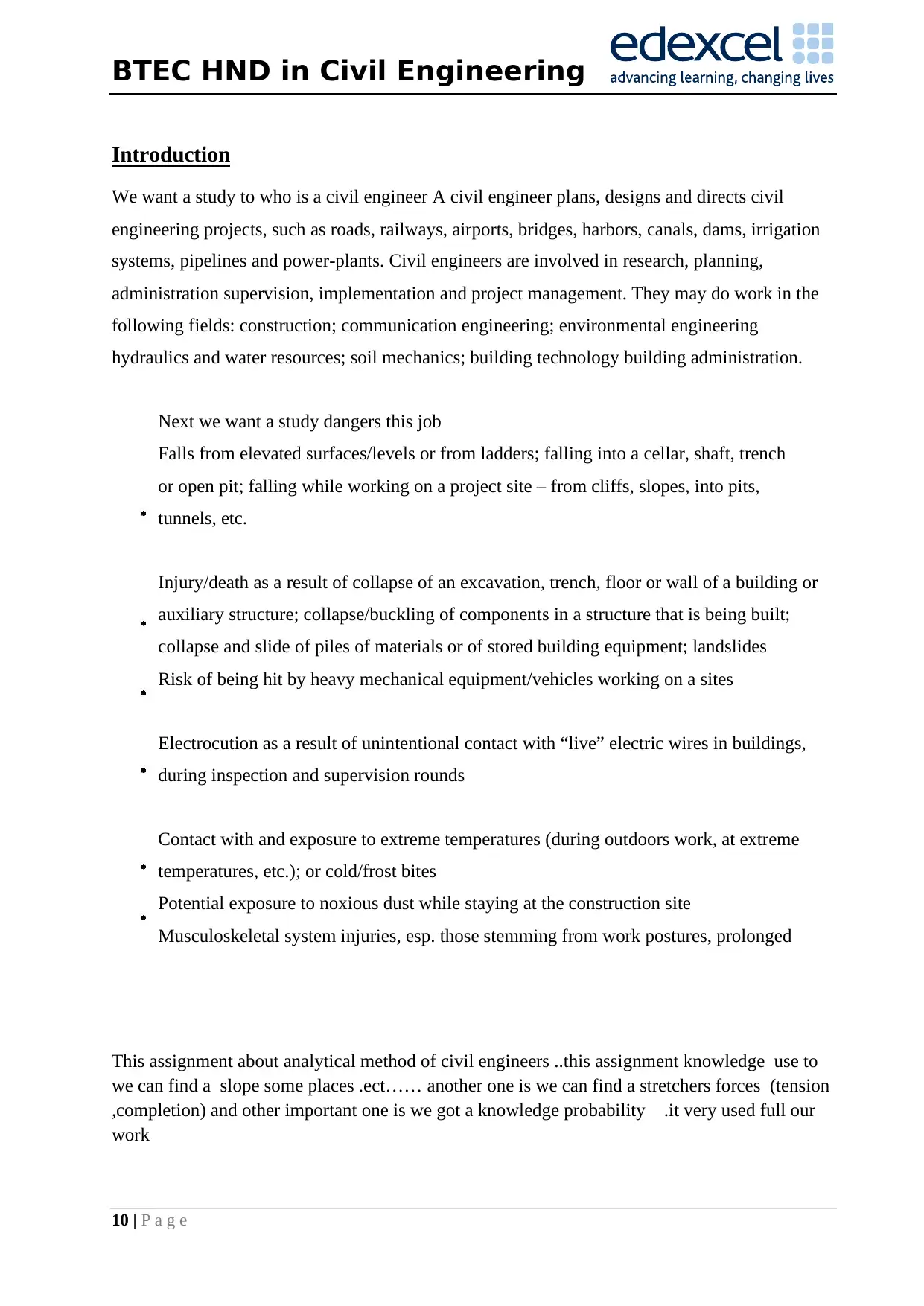
BTEC HND in Civil Engineering
10 | P a g e
Introduction
We want a study to who is a civil engineer A civil engineer plans, designs and directs civil
engineering projects, such as roads, railways, airports, bridges, harbors, canals, dams, irrigation
systems, pipelines and power-plants. Civil engineers are involved in research, planning,
administration supervision, implementation and project management. They may do work in the
following fields: construction; communication engineering; environmental engineering
hydraulics and water resources; soil mechanics; building technology building administration.
Next we want a study dangers this job
Falls from elevated surfaces/levels or from ladders; falling into a cellar, shaft, trench
or open pit; falling while working on a project site – from cliffs, slopes, into pits,
tunnels, etc.
Injury/death as a result of collapse of an excavation, trench, floor or wall of a building or
auxiliary structure; collapse/buckling of components in a structure that is being built;
collapse and slide of piles of materials or of stored building equipment; landslides
Risk of being hit by heavy mechanical equipment/vehicles working on a sites
Electrocution as a result of unintentional contact with “live” electric wires in buildings,
during inspection and supervision rounds
Contact with and exposure to extreme temperatures (during outdoors work, at extreme
temperatures, etc.); or cold/frost bites
Potential exposure to noxious dust while staying at the construction site
Musculoskeletal system injuries, esp. those stemming from work postures, prolonged
This assignment about analytical method of civil engineers ..this assignment knowledge use to
we can find a slope some places .ect…… another one is we can find a stretchers forces (tension
,completion) and other important one is we got a knowledge probability .it very used full our
work
10 | P a g e
Introduction
We want a study to who is a civil engineer A civil engineer plans, designs and directs civil
engineering projects, such as roads, railways, airports, bridges, harbors, canals, dams, irrigation
systems, pipelines and power-plants. Civil engineers are involved in research, planning,
administration supervision, implementation and project management. They may do work in the
following fields: construction; communication engineering; environmental engineering
hydraulics and water resources; soil mechanics; building technology building administration.
Next we want a study dangers this job
Falls from elevated surfaces/levels or from ladders; falling into a cellar, shaft, trench
or open pit; falling while working on a project site – from cliffs, slopes, into pits,
tunnels, etc.
Injury/death as a result of collapse of an excavation, trench, floor or wall of a building or
auxiliary structure; collapse/buckling of components in a structure that is being built;
collapse and slide of piles of materials or of stored building equipment; landslides
Risk of being hit by heavy mechanical equipment/vehicles working on a sites
Electrocution as a result of unintentional contact with “live” electric wires in buildings,
during inspection and supervision rounds
Contact with and exposure to extreme temperatures (during outdoors work, at extreme
temperatures, etc.); or cold/frost bites
Potential exposure to noxious dust while staying at the construction site
Musculoskeletal system injuries, esp. those stemming from work postures, prolonged
This assignment about analytical method of civil engineers ..this assignment knowledge use to
we can find a slope some places .ect…… another one is we can find a stretchers forces (tension
,completion) and other important one is we got a knowledge probability .it very used full our
work
Paraphrase This Document
Need a fresh take? Get an instant paraphrase of this document with our AI Paraphraser
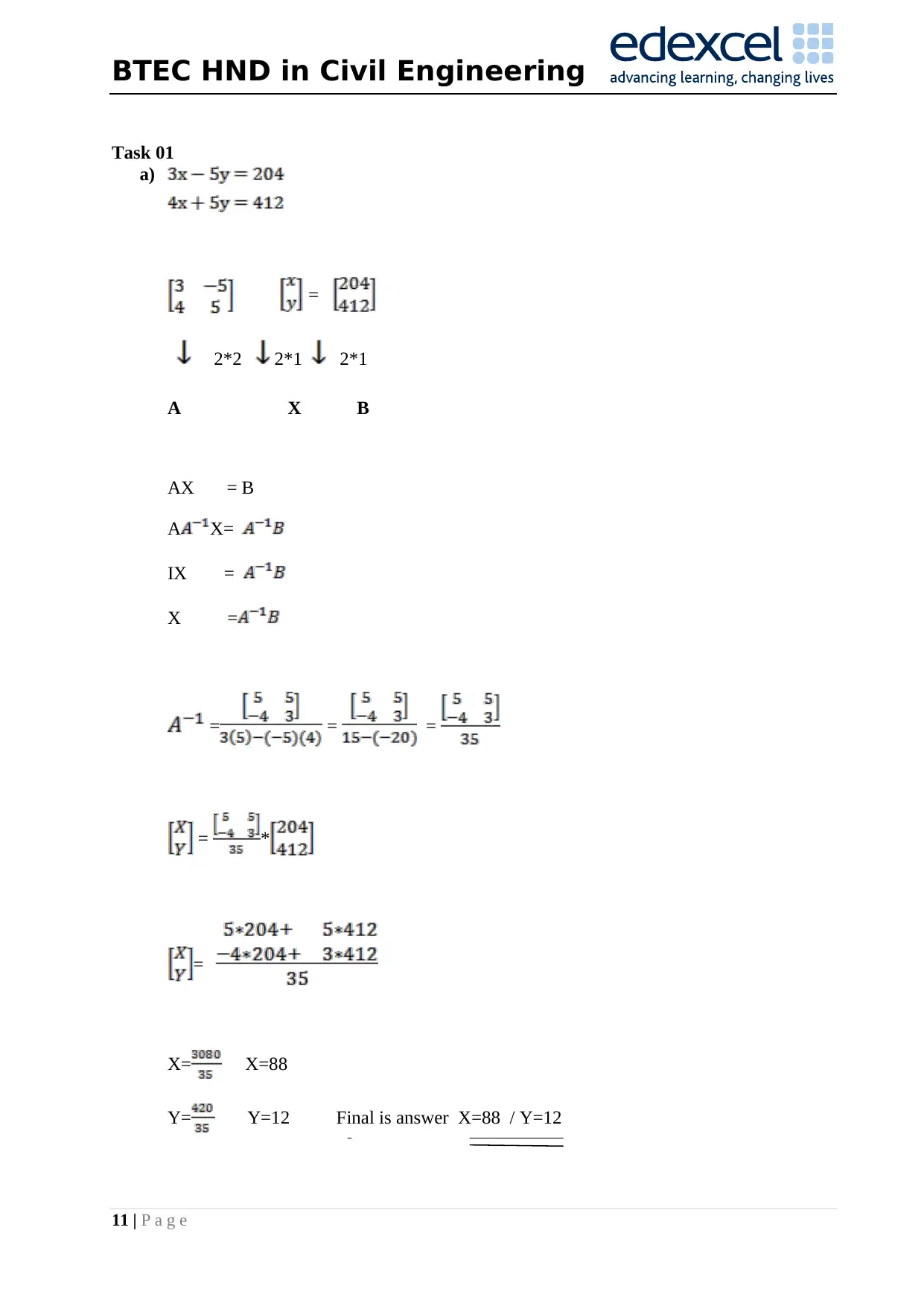
BTEC HND in Civil Engineering
11 | P a g e
Task 01
a)
=
2*2 2*1 2*1
A X B
AX = B
A X=
IX =
X =
= = =
= *
=
X= X=88
Y= Y=12 Final is answer X=88 / Y=12
11 | P a g e
Task 01
a)
=
2*2 2*1 2*1
A X B
AX = B
A X=
IX =
X =
= = =
= *
=
X= X=88
Y= Y=12 Final is answer X=88 / Y=12
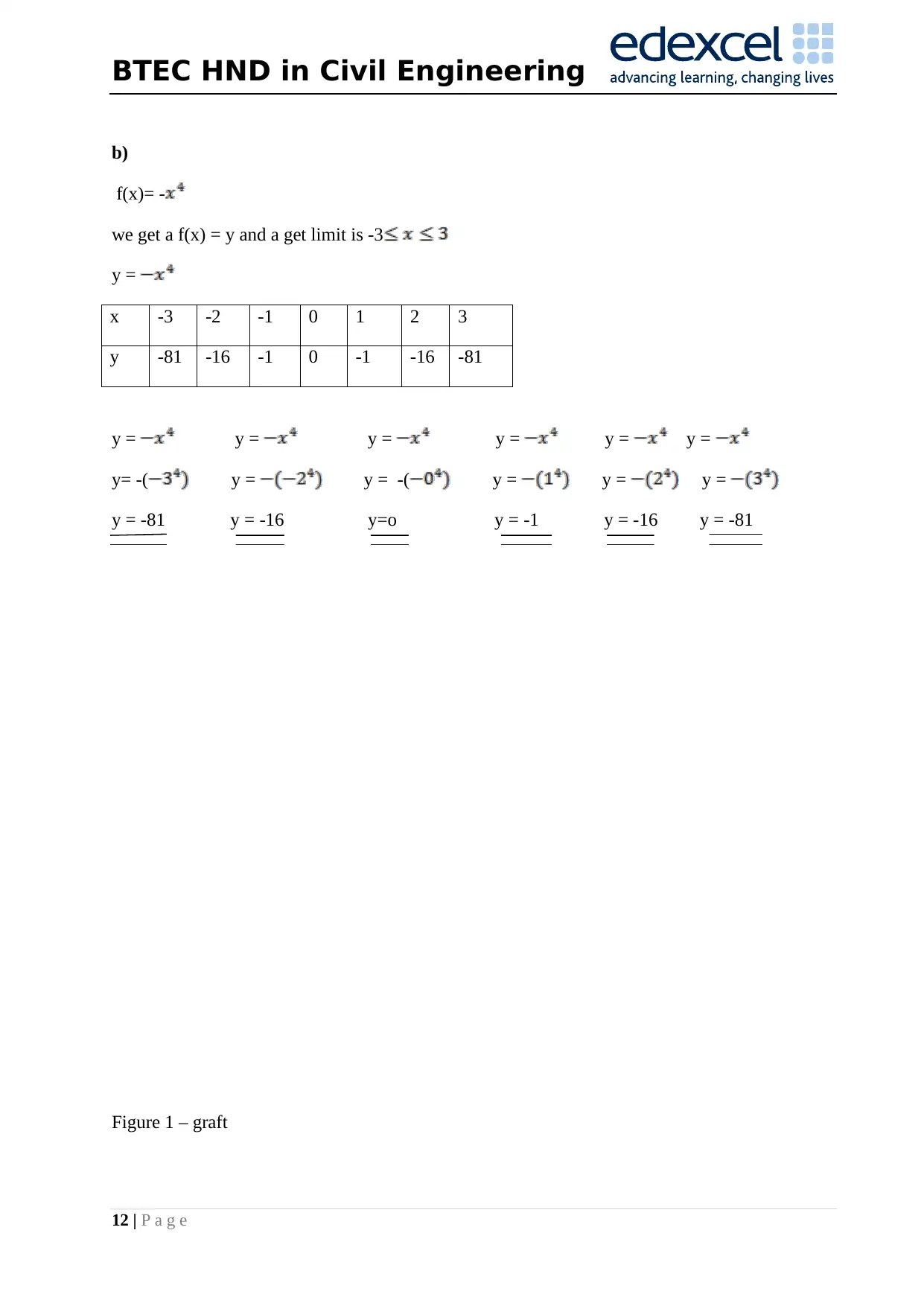
BTEC HND in Civil Engineering
12 | P a g e
b)
f(x)= -
we get a f(x) = y and a get limit is -3
y =
x -3 -2 -1 0 1 2 3
y -81 -16 -1 0 -1 -16 -81
y = y = y = y = y = y =
y= -( y = y = -( y = y = y =
y = -81 y = -16 y=o y = -1 y = -16 y = -81
Figure 1 – graft
12 | P a g e
b)
f(x)= -
we get a f(x) = y and a get limit is -3
y =
x -3 -2 -1 0 1 2 3
y -81 -16 -1 0 -1 -16 -81
y = y = y = y = y = y =
y= -( y = y = -( y = y = y =
y = -81 y = -16 y=o y = -1 y = -16 y = -81
Figure 1 – graft
⊘ This is a preview!⊘
Do you want full access?
Subscribe today to unlock all pages.

Trusted by 1+ million students worldwide
1 out of 42
Related Documents
Your All-in-One AI-Powered Toolkit for Academic Success.
+13062052269
info@desklib.com
Available 24*7 on WhatsApp / Email
![[object Object]](/_next/static/media/star-bottom.7253800d.svg)
Unlock your academic potential
Copyright © 2020–2025 A2Z Services. All Rights Reserved. Developed and managed by ZUCOL.





